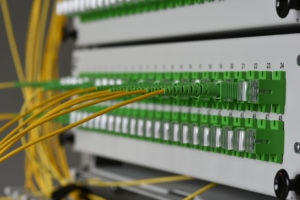Paving the Road to Your Storage System
June 13, 2018
Network

A storage system on its own is not useful. Sure, it can store data, but how are you going to put any data on it? Or read back the data that you just stored? You need to connect clients to your storage system. For this post, let’s assume that we are using block protocols like iSCSI or traditional block storage systems. This article also applies to file protocols (like NFS and SMB) and to some extent even to hyper-converged infrastructure, but we will get back to that later.
Direct attaching clients to the storage system is an option. There is no contention between clients on the ports, and it is cheap. In fact, I still see direct attached solutions in cases where low cost wins over client scalability. However, direct attaching your clients to a storage system does not really scale well in number of clients. Front-end ports on a storage array are expensive and limited.
ADD SOME NETWORK
Therefore, we add some sort of network. For block protocols, that is a SAN. The two most common used protocols are the FC protocol (FCP) and iSCSI. Both protocols use SCSI commands, but the network equipment is vastly different: FC switches vs. Ethernet switches. Both have their advantages and disadvantages, and IT professionals will usually have a strong preference for either of the two.
Once you have settled for a protocol, the switch line speed is usually the first thing that comes up. FC commonly uses 16Gbit and 32Gbit switches that have been entering the market lately. Ethernet, however, is making bigger jumps, with 10Gbit being standard within a rack or wiring closet and 25/40/100Gbit commonly used for uplinks to the data center cores.
The current higher speeds of Ethernet networks are often one of the arguments why “Ethernet is winning over FC.” 100Gbit Ethernet has already been on the market for quite some time, and the next obvious iteration of FC is “only” going to achieve 64Gbit.
OVERSUBSCRIPTION
Once you start attaching more clients to a storage system than it has storage ports, you start oversubscribing. 100 servers attached to 10 storage ports means you have on average 10 servers on each storage port. Even worse, if those servers are hypervisors running 30 virtual machines each, you will now have 300 VMs competing for resources on a single port.
Even the most basic switch will have some sort of bandwidth/port monitoring functionality. If it does not have a management GUI that can show you graphs, third-party software can pull that data out of the switch using SNMP. As long as traffic in/out does not exceed 70% you should be OK, right?
The challenge is that this is not the whole truth. Other, more obscure limitations might ruin your day. For example, you might be sending a lot of very small I/O to a storage port. Storage vendors often brag with 4KB I/O performance specs. 25,000 4KB IOps only accounts for roughly 100MB/s or 800Mbit (excluding overhead). So, while your SAN port shows a meager 50% utilization, your storage port or HBA could still be overloaded.
It becomes more complex once you start connecting SAN switches and distributing clients and storage systems across this network of switches. It is hard to keep track of how much storage and client ports traverse the ISLs (Inter Switch Links). In this case, it is a smart move to keep your SAN topology simple and to be careful with oversubscription ratios. Do the oversubscription math, and look beyond the standard bandwidth graphs. Check error counters, and in an FC SAN that has long distance links, check whether the Buffer-to-Buffer credits deplete on a port.
ETHERNET INSTEAD OF FC
The same principles apply to Ethernet. One argument why a company chooses an Ethernet-based SAN is because it already has LAN switches in place. In these cases, be extra vigilant. I am not opposed to sharing a switch chassis between SAN and normal client traffic. However, ports, ISLs, and switch modules/ASICS are prime contention points. You do not want your SAN performance to drop because a backup, restore, or large data transfer starts between two servers, and both types of traffic start fighting for the available bandwidth.
Identically, hyper converged infrastructure solutions like VxRail and other VMware VSAN place high demands on the Ethernet uplinks. Ideally, you would want to ensure that VMware VSAN uses dedicated, high-speed uplinks.






